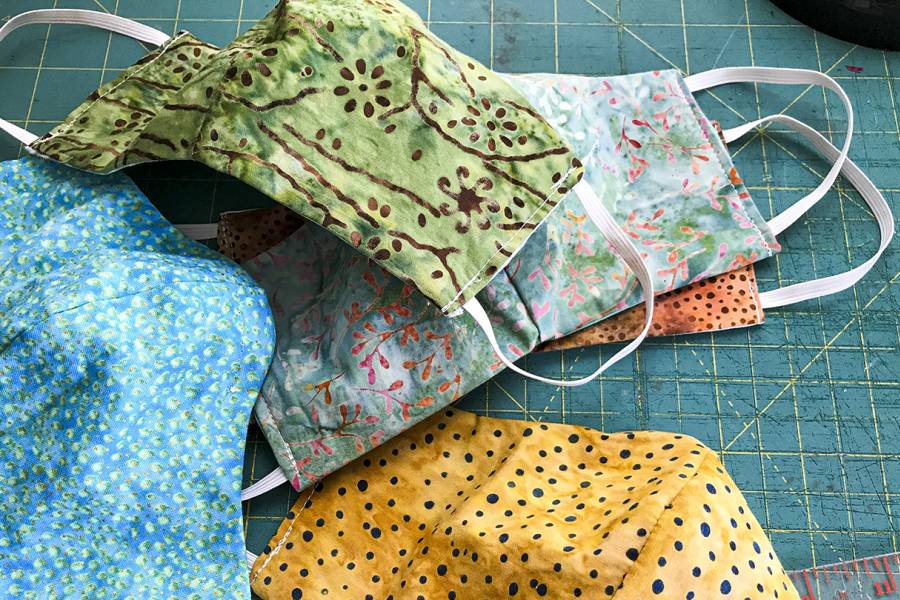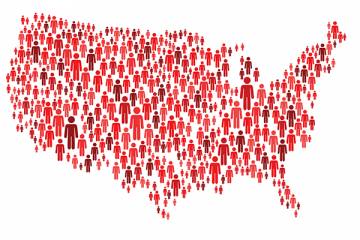In early April, the Centers for Disease Control and Prevention revised its guidance to recommend that in addition to social distancing measures, all Americans should wear masks when leaving the house for essential trips such as going to the grocery store or the pharmacy. Thursday, Brigham and Women's Hospital in Boston reported that new COVID-19 infections among hospital staff dropped by half after instituting a universal masking policy.
As best practices for limiting the spread of the coronavirus continue to evolve, the Hub spoke with Johns Hopkins Associate Professor Kirsten Koehler and Assistant Professor Ana Rule, both of the Department of Environmental Health and Engineering at the Bloomberg School of Public Health and the Whiting School of Engineering. They helped clarify how the "hierarchy of controls"—a prioritized method of controlling workplace hazards through actions such as social distancing and masks—can limit spread of the coronavirus. They also discussed the CDC's recent guidance and other questions related to mask use. This conversation has been edited for length and clarity.
Why did the CDC change its guidance to recommend that everyone wear a mask or face covering when leaving home?
Koehler: The CDC is concerned, in part, that there's a reasonably large portion of the population that are asymptomatic carriers of COVID-19 and are propagating the virus. For the general public, compliance will likely mean relying on a homemade mask, but it's important to do so with the mindset that we're wearing these masks to protect others, not necessarily to protect ourselves. The best self-protection is still the same: to stay home.
Rule: The CDC made the decision to encourage everyone to wear non-medical-grade masks, and we know that part of the rationale for that guidance was because of a concern that, without these guidelines, there could be hoarding of precious resources. In the past couple of weeks, we've seen how the stockpiles of essential medical personal protective equipment like N95 and surgical masks have dwindled greatly. The people who need these most are certainly the point of contact providers—those in hospitals and working with patients who are generating the aerosols that potentially contain the coronavirus. For those providers, PPE is their main protection.
Do homemade masks still offer adequate protection? What should people know about how best to approach the use of protective masks?
Koehler: To be clear, staying at home is the best option to protect yourself and others. If you can't do that, making a homemade mask is better than nothing. More broadly, my concern is that the general public has no training or guidance in the safe and proper way to use a homemade mask. If you use PPE as part of your job, you receive training about putting on and taking off this equipment. This training includes precautions like hand-washing whenever you put on or take off the mask. You should wash hands whenever you touch the mask and be careful about what you do whenever you take off the mask when you get home. A mask that you wear outside could potentially be covered in virus, and it's essential that when you take it off, you put it somewhere safe and out of the way, like where you keep laundry, and put on a different, clean mask whenever you have to go outside next.
Also see
Rule: In terms of the science, the bigger particles, which are the ones most likely to be filtered by a homemade mask, are going to fall quickly to the ground, anyway. The smaller particles will pass right through the mask. So, the mask will stop those larger particles from depositing on surfaces and potentially being picked up by the next person that touches that surface, for example at the supermarket. There's not a lot of science out there yet about tests to determine how a homemade mask protects the environment and people around you if you are contagious and shedding viruses. This is important, especially with so many asymptomatic people having this particular virus.
There are many different types of masks available, from the medical-grade N95 to surgical procedure masks to homemade masks and scarves. What is most preferable for non-medical workers? What types of materials from home might make for an effective mask?
Rule: There are a couple of papers that have actually tested different materials for filtration efficiencies against the most concerning and smallest particles, which are the ones that are the hardest to filter out. A couple of studies have shown that the materials that filter these particles the best are materials that are also the hardest to breathe through—thicker fabrics like hand towels or vacuum cleaner filters—but since it's really hard to breathe through them, they don't make for viable mask materials. Plus, none of them can provide a seal around the face. The smaller particles then go right around the filter. So there's no real protection from inhaling particles that might have virus. But any material will stop the bigger particles that could create contact points for the virus (such as on a hand railing or a table).
Koehler: For the small particles, I think there isn't a lot of difference in the various materials. Almost all of them remove less than 10% of really small particles.
Rule: But, and this is really important, even if you can get an N95 or surgical mask, please leave those for people who need to interact with patients. People who are actually caring for patients need to have those the most—we see people outside with these masks on and it's a problem since there's such a critical shortage for medical providers.
For those who decide to wear a mask, how can they do so effectively?
Koehler: Some people don't necessarily have a choice anymore—some states and cities have implemented mask requirements when in public. I do think that if people are going outside, whether required to or wearing a mask by choice, they should have the mindset that, "I'm wearing this to protect someone else, not to protect myself." Essentially, assuming that you are the contagious one, even if you feel perfectly healthy. If you think this way, it can lead to safer choices—for example, you might choose to limit your exposure by going to fewer stores and going outside less and maintaining social distancing standards of at least six feet of distance as much as possible, even if you are wearing a homemade mask.
Is it OK to reuse a mask, whether homemade or otherwise, and if so, how can one ensure that the mask is clean and safe to use again?
Koehler: To clean a homemade mask, throwing it in the washer and dryer is really fine. Make at least a couple of masks so that you can wash them between uses and, hopefully, since people should not be going out that much anyway, only having several masks should be enough.
Rule: I saw a video yesterday of someone making a mask made out of a sock—if it's that simple, really, you can have five or so around, and put them in the laundry after every use.
Koehler: I've seen bandanas folded up many times and held together with hair ties and looped over the ears—you could have several of those and keep putting them in the wash. You don't need to be a master seamstress to do this effectively. N95 and surgical masks should not be washed. To reuse these kinds of masks, it is best to place them in a paper bag in a warm place for at least 7 days before reusing them. This will give enough time for the virus to no longer be infectious.
For those without easy access to laundry facilities, storing homemade masks in paper bags is also an option. Recent data suggests the virus will lose infectivity after about 2 days from cloth masks.
When going to the pharmacy or grocery store for essentials, what can people do to minimize the risk of transmission? Should they wear other forms of PPE, like gloves?
Koehler: I don't recommend the use of gloves—if you're not a medical provider, they aren't helpful and, like with masks, people are likely using them incorrectly. If you were going to wear gloves, to do so effectively would mean never using your phone, wallet, or purse because as soon as you touch any of those high-touch surfaces then the gloves aren't effective anymore. They're also a huge environmental waste and it's not worth the effort and pollution and wastefulness to wear them.
Rule: Not only that, gloves can likely give you a false sense of security because someone might think they are protected when they're really just as susceptible and distracted from other important prevention steps—like washing your hands. Plus, if you don't dispose of gloves properly they could be another source of contamination in the environment. Really, we need to remember that, in the hierarchy of controls, PPE is the last resort—it's been shown for many years that wearing things like masks and gloves is the least effective factor at controlling exposure. That's why social distancing, cleaning, and washing hands are the best ways to protect yourself from the virus.
Posted in Health, Voices+Opinion
Tagged q+a, coronavirus, covid-19










